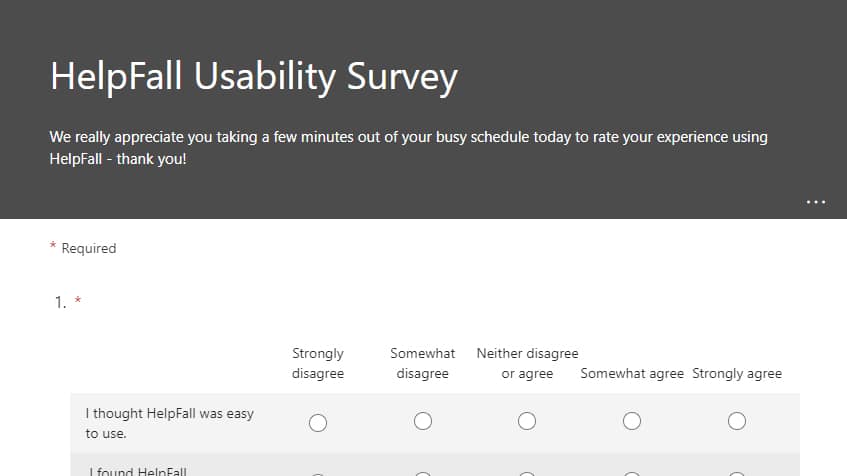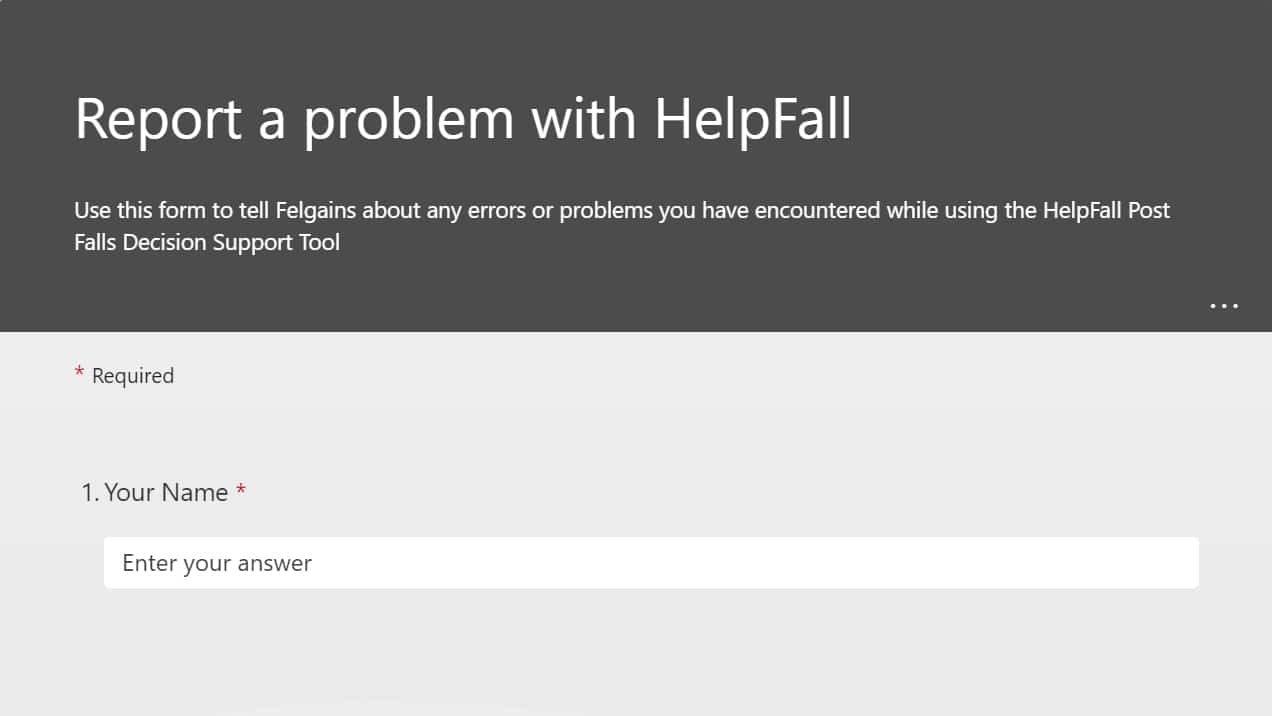HelpFall Support & Resources
On this page you will find all the resources and support information you need for HelpFall, including FAQs, contact details and much more.
Something missing? Please let us know on the contact details at the bottom of the page.
HelpFall Introduction Video
Watch this video to see our answers to the 8 most common questions we get about the HelpFall post falls decision support tool
In this short 5 minute introduction video, you will learn
- What HelpFall is
- How HelpFall works
- What HelpFall can achieve for both you and those in your care
HelpFall: your 8 most common questions answered
Watch this video to see our answers to the 8 most common questions we get about the HelpFall post falls decision support tool
You can find our full FAQs further down this page
HelpFall Feedback
Frequently Asked Questions about HelpFall
What accreditations does HelpFall have?
HelpFall is based with permission on South Western Ambulance NHS Foundation Trust’s Post Falls Guidance Pack for Care Providers, and draws on the latest guidance from sources such as NICE and the National Patient Safety Agency.
HelpFall is NHSX Digital Technology Assessment Criteria (DTAC) ready, which means it meets NHS standards in clinical safety, data protection, technical security, interoperability, and usability and accessibility. These new national baseline criteria for digital health technologies are designed to be used by healthcare organisations to assess suppliers as part of a procurement or due diligence process. Our full DTAC documentation is available on request. Find out more here.
HelpFall is also ORCHA certified, a mark of quality trusted by NHS England to assess and approve digital health technologies.
Who is responsible for the decision to lift a person who has fallen?
HelpFall’s guidance covers most situations care staff should encounter when a person falls, but it cannot foresee every possible scenario. It must be used together with clinical judgement (in nursing homes), common sense and in line with your duty of care. You can refer to the HelpFall Terms and Conditions of Use for more information.
Under the Health and Social Care Act 2008, it’s understood there are inherent risks in carrying out care and treatment, and a post fall response will not be considered unsafe if you can demonstrate you’ve taken all reasonable steps to ensure the health and safety of your service user, and to manage risks that may arise during care and treatment.
It’s important to consider that the risk of complications associated with leaving a person lying where they fell can be far greater than moving them into a more comfortable and appropriate position, even if they have a minor injury. Serious injuries and/or illnesses can develop whilst lying on the floor for a long period of time and this results in a need for hospital admission. Many people can be safely assisted, and this support could prevent the need to go into hospital and will improve their long-term outcomes.
For your peace of mind, the reporting functionality in HelpFall records your answer to each question in the tool. This provides a record of how the person who fell presented at the time of the assessment.
Using HelpFall, care workers can make an informed decision whether to lift a person who has fallen, and get a report to demonstrate the process they followed.
Do I need clinical training to use HelpFall?
HelpFall guides you through a simple set of questions, providing specific and understandable guidance at each step, to empower all care workers to respond to falls. However, it may be helpful to draw on the support of a Senior or Nurse. Before using HelpFall for the first time, you should watch the introduction video for an overview of how it works.
How do I access HelpFall?
HelpFall is accessed via a QR code that will be provided to you, normally as a sticker on your Raizer or the poster supplied.
It is a web application, so there is no need to download anything. Simply scan the QR code using your smartphone or tablet camera and you’ll be taken straight to the tool. Enter your unique access code and go
You will need an internet connection to access and use HelpFall, but it doesn’t use much data so the signal required is very small.
What equipment can HelpFall be used with?
HelpFall can be used alongside any patient lifting equipment, be that the Raizer chair or other lifting equipment such as a mobile hoist or inflatable cushion. In fact, in the app, when you reach the ‘ready to lift’ screen, there are a selection of short training videos on how to use the 5 most common pieces of falls lifting equipment.
What should I do if it’s an unwitnessed fall?
HelpFall is designed to help you check for common signs of new injury or symptoms regardless of whether the fall was witnessed or unwitnessed. However, if you have any concerns, you should contact a senior clinician for advice.
How can I assess if a person is injured using HelpFall if they have communication difficulties?
Most of the questions in the HelpFall tool can be answered by simply observing the person who has fallen.
However, tools such as the Abbey Pain Scale can be used in conjunction with HelpFall to help you assess whether service users who cannot verbalise are in pain. You can find the Abbey Pain Scale here.
What happens if a care home has a ‘no lifting’ policy?
Originally proposed in the 1990s by the Royal College of Nursing, ‘no lifting’ policies were designed to protect healthcare staff from injury by prohibiting the manual lifting of patients in all but exceptional or life-threatening situations.
However, in 2002 the Health & Safety Executive (HSE) published ‘Handling Home Care: Achieving safe, efficient and positive outcomes for care workers and clients’. This guidance stated that regulations did not prohibit all manual handling and encouraged a balanced approach that considered the risk to care workers along with the needs of the service user. Further, in 2004 A, B, X and Y v East Sussex County Council found that blanket ‘no lifting’ policies were highly likely to be unlawful.
Despite this, ‘no lifting’ policies remain in some care homes to this day, along with the misconception that it means that care workers should never attempt to move or lift a person who has fallen, even with patient lifting equipment.
While care workers should not be expected to physically ‘lift’ service users i.e., pick them up from the floor using only bodily force, they should be equipped to lift a person using safe manual handling techniques and equipment, in the case of minor or non-injury falls. It’s a statutory requirement that staff employed by care agencies and care homes should be suitably trained, equipped and of sufficient numbers at all times to carry out required manual handling operations, in a safe manner in compliance with their duty of care.
Of course, you should check for new injuries or symptoms before lifting a person, which is where HelpFall can support you.
There are several resources to support care homes with developing best practice policies for manual handling in falls response:
https://www.hse.gov.uk/healthservices/moving-handling.htm
https://www.hse.gov.uk/healthservices/moving-handling-equipment.htm
https://www.hse.gov.uk/pubns/priced/hsg220.pdf
https://aace.org.uk/wp-content/uploads/2020/10/AACE-FALLS-RESPONSE-09.2020-V4-HP.pdf
Does HelpFall comply with NICE guidelines on head injuries and anti-coagulants and/or antiplatelets?
NICE guidelines state that adults who have sustained a head injury and are taking anti-coagulants and/or antiplatelets should be considered for a CT head scan within 8 hours (unless there are indicators of severe head injury requiring a CT head scan within 1 hour). Head injury is defined as ‘any trauma (external force) to the head other than superficial injuries to the face’.
HelpFall follows these guidelines to help you check for signs and symptoms of head injury and will direct you to call 999 for an ambulance where common red flags are apparent. For added assurance, if the person who has fallen has no signs of head injury but is taking anti-coagulants and/or antiplatelets, HelpFall refers you to a community provider for follow-up and advice.
What is the purpose of HelpFall?
The primary purpose of HelpFall is to support you to decide whether to lift a person who has fallen, not whether an ambulance or emergency care is needed. For example, there may be situations where it is safe to lift a person, and then contact NHS 111 or a community provider (such as Urgent Community Response Services) for follow up and advice, who may refer a patient on to hospital-based care for tests or treatment.
Does HelpFall meet the standards of Association of Ambulance Chief Executives’ (AACE) Falls Response Governance Framework?
The guidance given by NHS England in “Going further for winter: community falls response model” states that ICBs and ambulance services should adopt AACEs’ Falls Response Governance Framework as a minimum national standard as part of pathways.
HelpFall’s traffic light system of major, minor and no injury/illness falls aligns with the Level 1, 2 and 3 response model set out in the framework.
Is HelpFall proven?
Suffolk and North East Essex ICB have been trialling HelpFall in their care homes, along with the Raizer lifting chair, which has reduced ambulance call-outs to falls and reduced the percentage unnecessary conveyances. You can ready the full case study here. On the main HelpFall page you can find 2 pieces of evidence that prove the effectiveness of the HelpFall decision support process.

